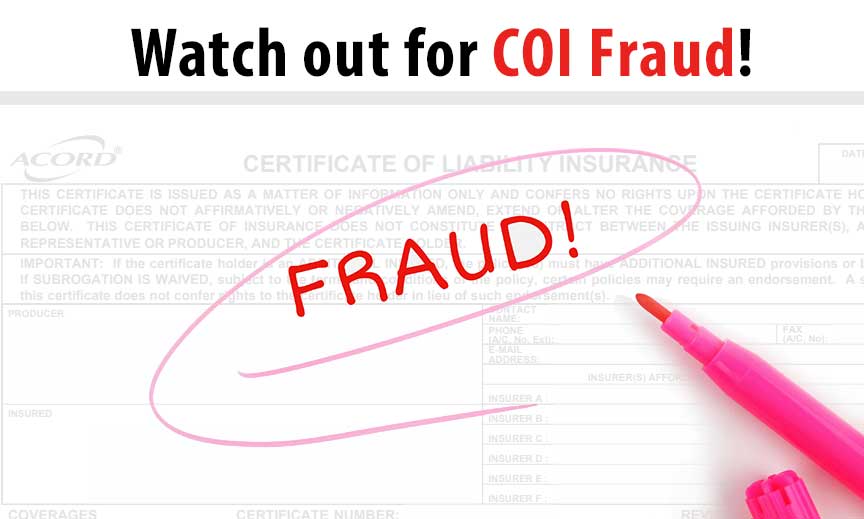
Detecting Fraudulent Certificates of Insurance
 With over 7,000 companies operating in the US Insurance marketplace, more than $1 trillion in premiums is collected each year. According to the Federal Bureau of Investigation, the enormous size of the industry alone makes it a target ripe for fraud. In fact, the FBI estimates that the total cost of insurance fraud is more than $40 billion a year. That amount of fraud costs US families between $400 and $700 more in increased premiums annually.
With over 7,000 companies operating in the US Insurance marketplace, more than $1 trillion in premiums is collected each year. According to the Federal Bureau of Investigation, the enormous size of the industry alone makes it a target ripe for fraud. In fact, the FBI estimates that the total cost of insurance fraud is more than $40 billion a year. That amount of fraud costs US families between $400 and $700 more in increased premiums annually.
Fraud is no stranger when it comes to certificates of insurance. These common documents play an important role in commerce and when their integrity has been compromised, it can lead to a long list of problems. The most serious of course is that you or your vendor will not be fully covered should an issue arise.
Recognizing fraud is key to avoiding these potential problems. Below are the top 5 ways to recognize that a Certificate of Insurance may not be legitimate.
- The Insurance Company Information is Inconsistent
The best way to determine if the insurance company identified on the Certificate of Insurance is legitimate is to search for them online. Make sure the website information matches the information on the COI. Make sure to identify any information that is inconsistent. This may include the address of the corporate headquarters, corporate email address, phone number, etc. If there are inconsistencies in any of the information you might want to reach out to the company directly to verify. - The Certificate is not an ACORD Certificate
Most COIs for insurance agencies are presented on what is called the ACORD 25 form. The ACORD form is an industry standard one-page form that proves to potential clients you have enough business liability insurance for the specific job, project, or contract you are looking to secure. An official ACORD form will be stamped with “ACORD” on the top left corner of the form. If the “ACORD” logo is missing from the form, it might not be a legitimate COI and you should do additional research into the authenticity of the document. - Expiration Dates
The expiration dates on a Certificate of Insurance are important for many reasons and can be extremely helpful in determining the legitimacy of a COI. First, you should check to see if the actual dates of coverage of current. You never want to just assume the information is correct and current, especially the coverage dates. Second, you want to make sure that the dates on the ACORD 25 form have not been tampered with. Are they contained within the center of the allotted box on the form? Are they in the same font as the policy number? If you find either of these things, the certificate may not be genuine. - Information Consistency
All of the information presented on any COI should be consistent in look and style. There should be no misspelled words, names, or addresses. The font should be the same across all the information presented in the document. This includes license numbers, social security numbers, names, addresses, etc. If you see these types of inconsistencies, then you should question the authenticity of the form. - “Additional Insured” Marked Incorrectly
There are two items on a COI that can be very telling when it comes to fraud. These are the Additional Insured field and the Subrogation Waived field. If these two fields are not needed for this particular use of the form, then they should be blank. If someone has marked them with a marking such as a check mark, “X” or “N”, this should be a red flag. Credible insurance professionals know how to fill these fields out and would not make this mistake.
These are just five of the possible ways to identify potential fraud when it comes to Certificates of Insurance. While we hope that you found this article interesting and informative, it is important to understand that the five things outlined above are simply different ways to potentially spot fraud. They should not be viewed as any sort of foolproof fraud detection strategy.
The best way to avoid fraud is to always double check with your insurance professional. Insurance brokers use electronic certificate distribution companies like Certificate Exchange to help safely and securely transmit COIs. By using a secure COI transmission service, brokers can protect the integrity of their COIs and minimize the COI fraud risk to their clients.
Contact us